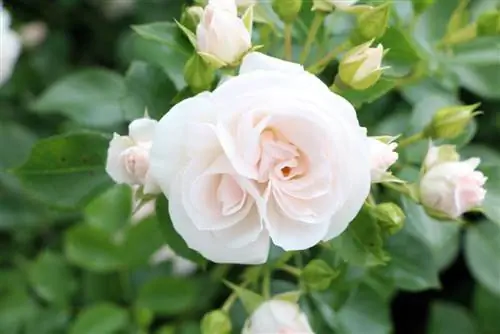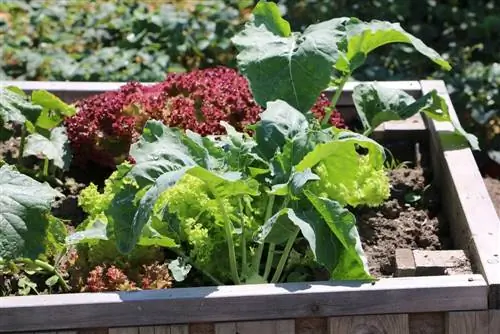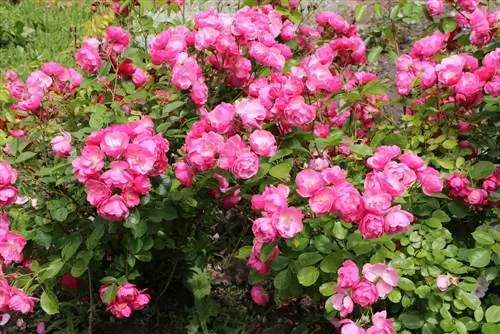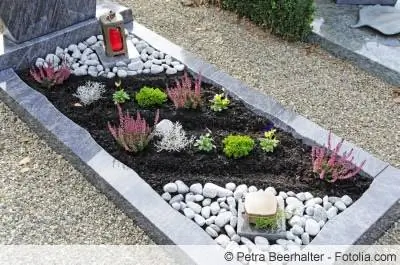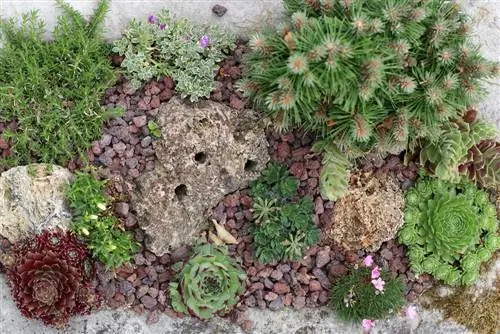- Author admin [email protected].
- Public 2023-12-17 03:39.
- Last modified 2025-01-24 12:45.
Roses are considered little divas by many hobby gardeners. That's why they prefer to keep their hands off it. Roses don't pose such a big challenge in the garden. If you plan a rose bed correctly in advance and pay attention to the basic things when caring for them, you won't have any more work with them than with other garden flowers. And he gets a true queen to hold court with him.
Location
The most important point in successfully cultivating roses in the garden is the right location. Of course, the location is of central importance for every plant. With roses, however, it plays an even larger role. Anyone who is thinking about creating a rose bed should therefore carefully examine what alternative locations their garden offers. Basically, roses love the sun and need a lot of light. A location that is as sunny as possible is therefore mandatory. At the same time, it must also be protected from the wind, otherwise the fragile leaves of the flowers will be damaged. When planning, it is also important to take into account that you also want to see your roses and enjoy their scent. A more or less hidden rose bed is a waste - even if everything else fits in the location.
Floor
The soil is almost as important as the location for a rose bed. Something like a happy medium has to be found here. Roses cannot cope with soil that is either too firm or too light. Basically, the soil should be loose. A soil mixture that is rich in humus, has some clay and a certain amount of sand is ideal. A high proportion of clay in the soil puts an enormous strain on the plants from the start, as their roots then receive far too little air. As a rule, they cannot thrive there. If the soil is too sandy, i.e. too light, it is best to enrich it with
- some clay
- Compost
- Rock flour
- and possibly also smaller stones.
If the structure or type of soil is not suitable, but this is the perfect location for a rose bed, you should think about changing the soil. It is best to replace the existing soil with special rose soil from a gardening store. However, such an approach only really makes sense for relatively small beds, otherwise the costs can quickly get out of hand.
Planting
As a rule of thumb: the best time to plant roses is autumn - specifically from the beginning of October to the end of November. It is best to use so-called bare root roses, which are easily available to buy during this time. If everything is done correctly when planting, the roots will usually survive long-term frosts during the winter and then sprout really well in the spring. In principle, you could also plant roses in spring, but their development usually lags significantly behind autumn roses. When planting, attention must be paid to the following aspects:
- First loosen up the soil heavily with a rake
- Dig a sufficiently deep planting hole; the roots must not be bent or compressed
- The grafting site of the rose must be below the surface of the earth
- Fill the hole with soil and press it down lightly, but under no circumstances step down
- water heavily
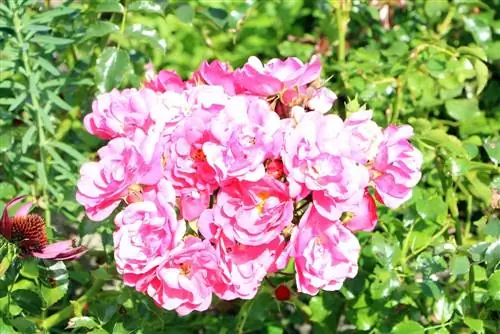
If you want to use container roses instead of bare-root roses, you essentially proceed in the same way. However, the planting hole dug should be approximately twice the size of the rose's planter.
Note:
Never plant roses in soil that has already contained a rose. If you are forced to do this, the soil must be replaced over a large area.
Planting spacing
Usually several roses are planted in one bed. To ensure that there are no problems later, it is important to ensure there is sufficient distance between the individual plants. The distances differ from species to species or from variety to variety:
- Noble or floribunda roses: planting distance 40 to 50 cm
- Shrub and climbing roses: one to 1.5 m
- ground-covering roses: 50 to 80 cm
- Dwarf roses: 30 cm
Sufficient planting distances are important so that the individual plants can develop well and do not get in each other's way. It is therefore ideal to include them in the considerations when planning the rose bed.
Design
A rose bed in the garden can be beautifully staged. Of course, the most important thing is the combination with other plants or stones. With the right companion plants, the natural beauty of the roses can be clearly emphasized. Since roses become bare to a significant extent, the plants can be used to conceal these areas. Above all, they ensure that diseases and pests can spread less easily than in pure rose beds. In addition to their optical function, the companion plants in the rose bed also have a protective function. By the way, the immediate surroundings of the bed should also be taken into account. Boxwood and silver leaf, for example, are perfect for framing the bed.
Perennials
Typically, small bed and shrub roses are combined with perennials. Phlox and delphiniums are particularly worth mentioning here. Not to forget that lavender has proven to be a more ideal companion to roses in many ways. If you decide on a combination with one or more of these plants, you also have to pay attention to the planting distances. Both types of plants, roses and perennials, need enough space to develop. It's best to be a little more generous here. It should also be clear to you that the perennials planted as companion plants should also have similar requirements in terms of location and soil conditions. This is of course the case with phlox, delphiniums and lavender
Design
There are actually hardly any limits to creativity when designing a rose bed in your own garden. You can have fun there to your heart's content. What is important, however, is that it should always be about staging the roses. You have to be the center of attention and not let the show steal your attention. Natural stones are therefore recommended when designing. On the one hand, they appear impressive enough to provide special visual appeal, but on the other hand, they do not push themselves into the foreground. Especially in so-called natural gardens, stones can be the perfect partner in or on the rose bed.

